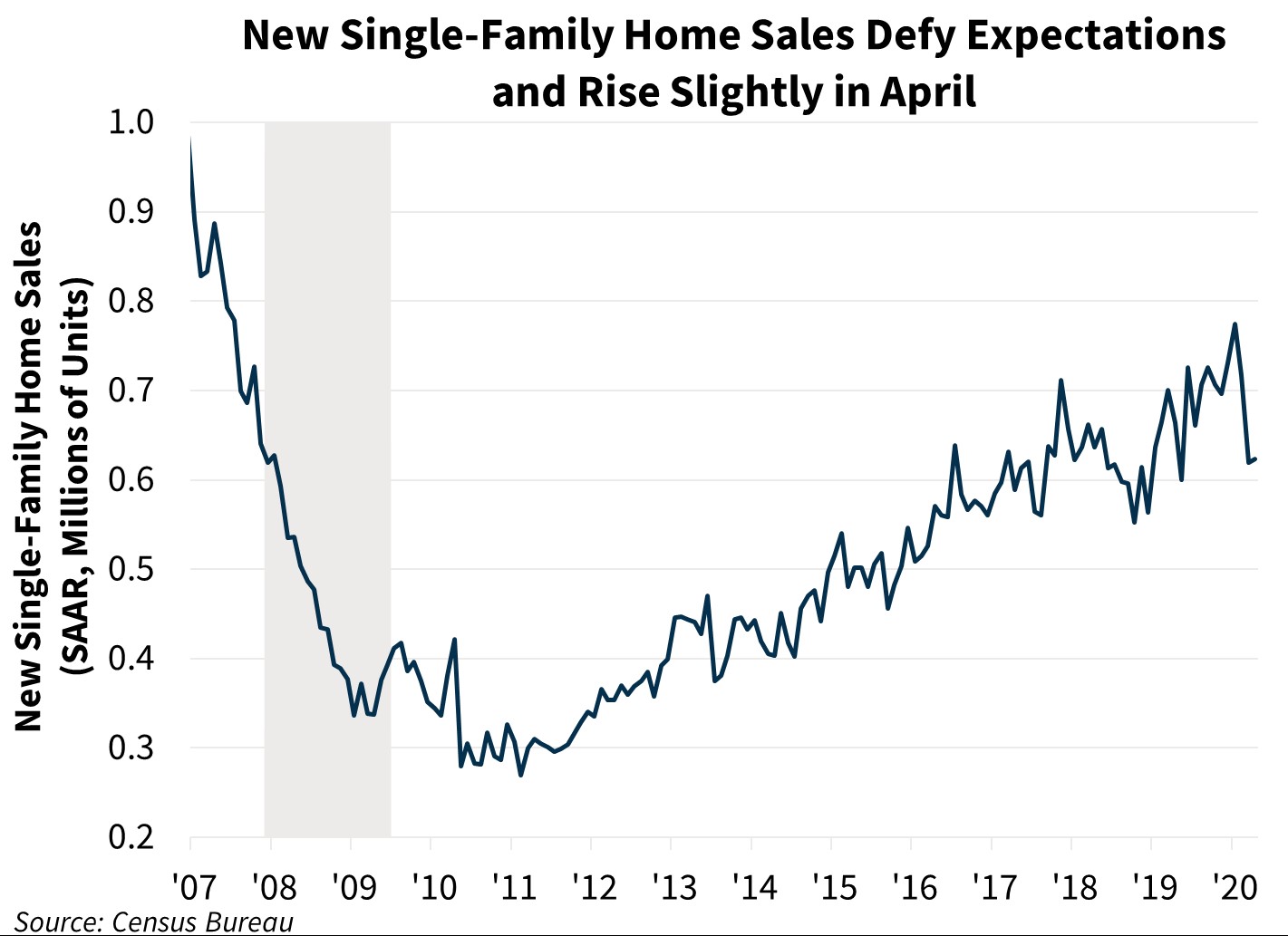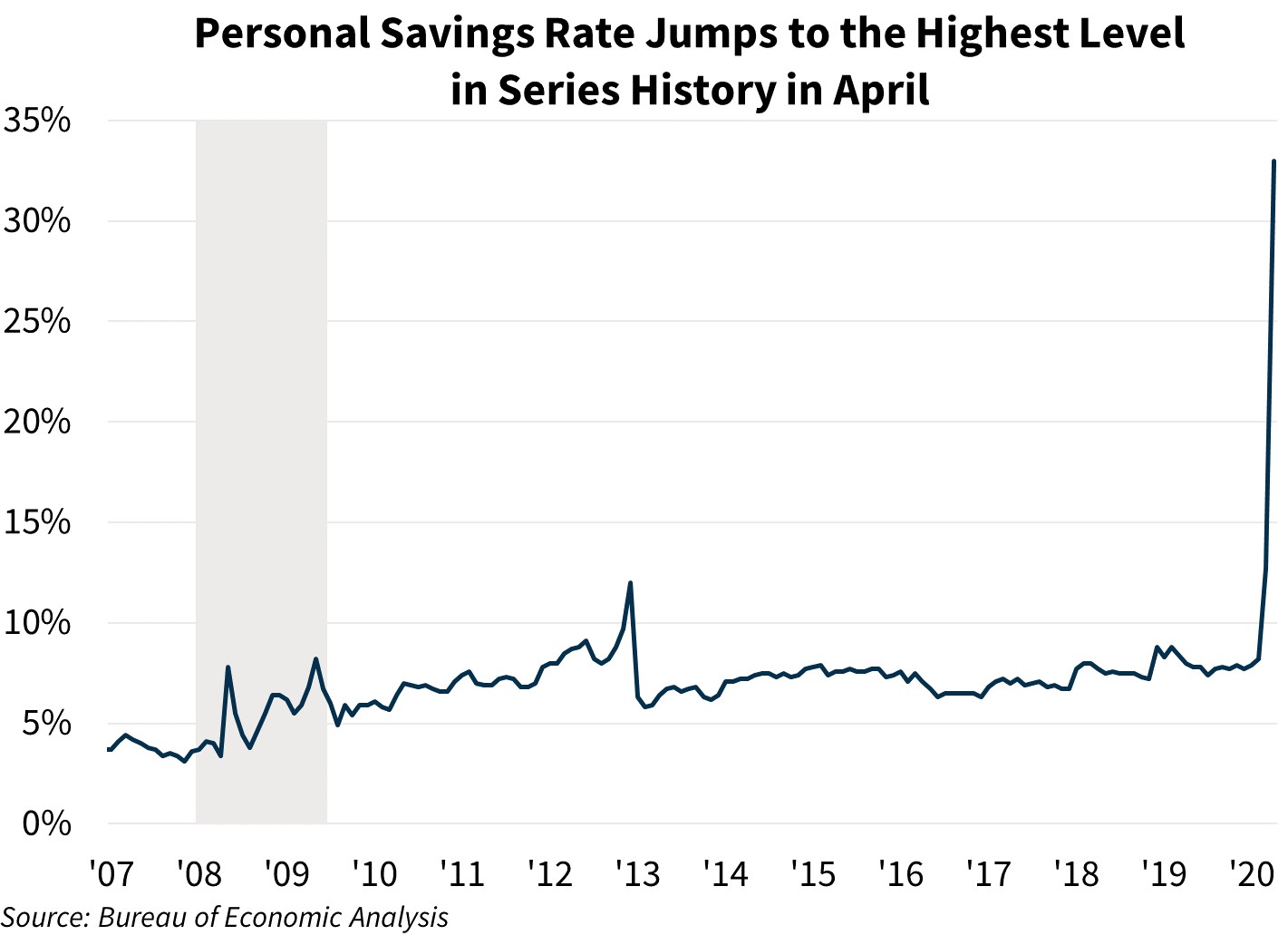Consumption Poised to Grow as States and Businesses Begin to Reopen
Key Takeaways:
- Gross domestic product, adjusted for inflation, fell 5.0 percent annualized in Q1 2020, two-tenths lower than the advanced estimate, according to the second estimate from the Bureau of Economic Analysis. Pre-tax corporate profits fell 13.9 percent from the prior quarter (not annualized), the largest quarter-over-quarter decline since Q4 2008.
- Personal income, adjusted for inflation, jumped 11.0 percent in April, according to the Bureau of Economic Analysis. This was the largest monthly increase since the series began in 1959. However, this was driven by stimulus checks and expanded unemployment insurance. Excluding transfer payments, real personal income fell 6.3 percent, the largest decline in series history. The personal savings rate surged to 33.0 percent, the highest level on record.
- Durable goods orders fell 17.2 percent in April, according to the Census Bureau, the largest decline since August 2014. Orders for core capital goods (nondefense excluding aircraft) decreased 5.8 percent, the largest decline in 10 years, while core shipments fell 5.4 percent, the largest decline since January 2009.
- The Conference Board Consumer Confidence Index rose 0.9 points in May to 86.6. The index of consumer confidence in their present situation fell 1.9 points 71.1, the lowest level since August 2013. The consumer expectations index rose 2.6 points to 96.9.
- New single-family home sales rose 0.6 percent in April to a seasonally adjusted annualized rate (SAAR) of 623,000, according to the Census Bureau. From a year ago, new home sales fell 7.8 percent and the number of new homes for sale fell 2.4 percent, the eighth consecutive month of inventory decline.
- The National Association of REALTORS® Pending Home Sales Index, which records contract signings of existing homes and typically leads closings by one to two months, dropped 21.8 percent in April to 69.0, the largest decline since the series began in 2001.
- Mortgage applications rose 2.7 percent for the week ending May 22, according to the Mortgage Bankers Association. The increase was driven entirely by a surge in purchase applications, which increased for the sixth consecutive week by 8.6 percent to the highest level since the end of January. Refinance applications edged down by 0.2 percent.
Forecast Impact
Data from April continue to highlight the vast slowdown in economic activity during the month. While personal income in April jumped by an historic amount, this increase was entirely due to the unprecedented fiscal stimulus policies outlined in the CARES Act, which were designed to combat the effects of coronavirus-related closings. Despite this surge in income, consumer spending fell sharply in April as most businesses remained closed, supporting our expectation of a significant contraction in consumer spending in the second quarter. The decline in core durable goods orders suggests a contraction in business investment in the second quarter, though potentially not as sharp of a decline as the headline number may suggest, as the decline was primarily attributed to a sharp reduction in orders of motor vehicles and defense aircraft. However, there is evidence that supports a rebound of economic activity in the coming months. The historically high savings rate means that some consumers will have the capacity to spend significantly as more states and businesses reopen. The modest rise in consumer confidence and expectations suggests at least some increase is likely. While increased spending in the coming months is unlikely to outweigh the sharp declines seen in April, these datapoints do support our expectation of a partial rebound in the third quarter. While the steep decline in pending sales in April was unsurprising, there are more signs of a recovery in housing. The slight increase in new home sales in April defied consensus expectations, and purchase applications continue to surprise to the upside, rising for sixth consecutive week. This dynamic could simply reflect the temporary effect of historically low mortgage rates plus a shifting of buyers that had planned to purchase in March to a later time period. However, we believe there is a possibility that demand is broader and more resilient than originally expected. It is likely that our forecast for home sales in the coming months will be upwardly revised at least modestly.


Details on Key Takeaways and Other Releases
- Gross domestic product, adjusted for inflation, fell 5.0 percent annualized in Q1 2020, two-tenths lower than the advanced estimate, according to the second estimate from the Bureau of Economic Analysis. Consumer spending and business investment were both upwardly revised, though each still fell sharply. Residential investment was revised downward by 2.5 percentage points to 18.5 percent. The biggest change from the initial estimate was in inventory investment, which subtracted 1.4 percentage points from growth, nine-tenths more than the initial estimate suggested. After-tax corporate profits dropped 14.2 percent. From a year ago, pre-tax corporate profits dropped 8.5 percent, the largest annual decline since Q4 2015.
- Personal income, adjusted for inflation, jumped 11.0 percent in April, according to the Bureau of Economic Analysis. Real disposable income rose 13.4 percent, though April personal consumption expenditures fell sharply by 13.2 percent. From a year ago, the PCE price index rose 0.5 percent, a deceleration of eight-tenths from last month, while the core PCE price index rose 1.0 percent, the slowest pace of annual growth since 2011.
- Durable goods orders fell 17.2 percent in April, according to the Census Bureau, the largest decline since August 2014. Excluding transportation, new orders dropped 7.4 percent, highlighting that much of the decline is due to the sudden shutdown in transportation across the country, with new orders for motor vehicles and parts falling 52.8 percent from the prior month, the largest decline since the new orders series began in 1992. Shipments of durable goods dropped 17.7 percent, the largest decline in the 62-year-long history of the series.
- New single-family home sales rose 0.6 percent in April to a SAAR of 623,000, according to the Census Bureau. Sales in the prior two months were revised down by a total of 32,000. Sales rose in every region except for the West. The median sales price (not seasonally adjusted) dropped 8.6 percent year over year, the largest annual decline since November 2018. From a year ago, new home sales fell 7.8 percent and the number of new homes for sale fell 2.4 percent, the eighth consecutive month of inventory decline. The months’ supply ticked down one-tenth to 6.3 months.
- The National Association of REALTORS® (NAR) Pending Home Sales Index, which records contract signings of existing homes and typically leads closings by one to two months, dropped 21.8 percent in April to 69.0. Sales fell in every region. From a year ago, pending sales declined 33.8 percent. According to the press release, in the most recent flash survey, NAR found that "34% of Realtors® reported successfully completing nearly all aspects of transactions while adhering to social distancing procedures."
Economic and Strategic Research Group
May 29, 2020
Opinions, analyses, estimates, forecasts and other views of Fannie Mae's Economic and Strategic Research (ESR) Group included in these materials should not be construed as indicating Fannie Mae's business prospects or expected results, are based on a number of assumptions, and are subject to change without notice. How this information affects Fannie Mae will depend on many factors. Although the ESR group bases its opinions, analyses, estimates, forecasts and other views on information it considers reliable, it does not guarantee that the information provided in these materials is accurate, current or suitable for any particular purpose. Changes in the assumptions or the information underlying these views, including assumptions about the duration and magnitude of shutdowns and social distancing, could produce materially different results. The analyses, opinions, estimates, forecasts and other views published by the ESR group represent the views of that group as of the date indicated and do not necessarily represent the views of Fannie Mae or its management.
